Carmelites
The Carmelites, formally known as the Order of the Brothers of the Blessed Virgin Mary of Mount Carmel (Latin: Ordo Fratrum Beatissimæ Virginis Mariæ de Monte Carmelo) or sometimes simply as Carmel by synecdoche, is a Roman Catholic mendicant religious order for men and women. Historical records about its origin remain very uncertain, but it was probably founded in the 12th century on Mount Carmel in the Crusader States.[1] Berthold of Calabria has traditionally been associated with the founding of the order, but few clear records of early Carmelite history have survived.[2] The order of Carmelite nuns was formalised in 1452.[3]
Ordo Fratrum Beatissimæ Virginis Mariæ de Monte Carmelo | |
 | |
| Abbreviation | Carmelites (O.Carm) |
|---|---|
| Motto | Zelo zelatus sum pro Domino Deo exercituum (Vulgate, 1 Kings 19:10;14) ("With zeal have I been zealous for the Lord God of hosts") |
| Formation | Late 12th century |
| Type | Mendicant Catholic religious order |
| Legal status | Institute of Consecrated Life |
| Headquarters | 138 Via Giovanni Lanza Rome, Italy |
Prior General | Míċéal O'Neill |
| Website | www.ocarm.org |
Charism
The charism (or spiritual focus) of the Carmelite Order is contemplation. Carmelites understand contemplation in a broad sense encompassing prayer, community, and service. These three elements are at the heart of the Carmelite charism. The most recent statement about the charism of Carmel was in the 1995 Constitutions of the Order, in which Chapter 2 is entirely devoted to the idea of charism. Carmel understands contemplation and action to be complementary, not contradictory. What is distinctive of Carmelites is the way that they practice the elements of prayer, community and service, taking particular inspiration from the prophet Elijah and the Blessed Virgin Mary, patrons of the order.[4]
The order is considered by the Catholic Church to be under the special protection of the Blessed Virgin Mary, and thus has a strong Marian devotion to Our Lady of Mount Carmel. As in most of the orders dating to medieval times, the First Order is the friars (who are active/contemplative), the Second Order is the nuns (who are cloistered), and the Third Order consists of laypeople who continue to live in the world, and can be married, but participate in the charism of the order by liturgical prayers, apostolates, and contemplative prayer. There are also offshoots such as active Carmelite sisters.
History
Origins
Carmelite tradition traces the origin of the order to a community of hermits on Mount Carmel,[5] during the initial period of the formation of the Crusader states. A group of men had gathered at the well of Elijah on Mount Carmel. These men, who had gone to Israel from Europe either as pilgrims or as crusaders, chose Mount Carmel in part because it was the traditional home of Elijah.[6] The foundation is believed to have been dedicated to the Blessed Virgin Mary. (The Carmelites were forced to leave the site, and the Holy Land, in 1291. Their original conventual buildings were destroyed several times, but members of the order were able to return in the nineteenth century under the Ottoman Empire. A monastery of Discalced Carmelite friars was built close to the original site under the auspices of Julius of the Saviour and consecrated on 12 June 1836.)
Some time between 1206 and 1214 the hermits, about whom very little is known, approached Albert of Jerusalem, the Latin Patriarch of Jerusalem and papal legate, for a rule. (Albert is credited with giving a rule to the Humiliati during his long tenure as Bishop of Vercelli, and was well-versed in diplomacy, being sent by Pope Innocent III as Papal Legate to what was known as the Eastern Province.) Albert created a document, the Rule of St Albert,[6] which is both juridically terse and replete with Scriptural allusions, thereby grounding the hermits in the life of the universal Church and their own aspirations.
The rule consisted of sixteen articles, which enjoined strict obedience to their prior, residence in individual cells, constancy in prayer, the hearing of Mass every morning in the oratory of the community, vows of poverty and toil, daily silence from vespers until terce the next morning, abstinence from all forms of meat except in cases of severe illness, and fasting from Holy Cross Day (September 14) until the Easter of the following year.
The Rule of St. Albert addresses a prior whose name is only listed as "B." When later required to name their founders, the Brothers referred to both Elijah and the Blessed Virgin as early models of the community. Later, under pressure from other European mendicant orders to be more specific, the name "Saint Berthold" was given, possibly drawn from the oral tradition of the order.
Early history

Virtually nothing is known of the Carmelites from 1214, when Albert died, until 1238. The Rule of St. Albert was approved by Pope Honorius III in 1226, and again by Pope Gregory IX in 1229, with a modification regarding ownership of property and permission to celebrate divine services. The Carmelites next appear in the historical record, in 1238, when with the increasing cleavage between the West and the East, the Carmelites found it advisable to leave the Near East. Many moved to Cyprus and Sicily.[7]
In 1242, the Carmelites migrated west, establishing a settlement at Aylesford, Kent, England,[8] and Hulne, near Alnwick in Northumberland. Two years later, they established a chapter in southern France. Settlements were established at Losenham, Kent, and Bradmer, on the north Norfolk coast, before 1247. By 1245 the Carmelites were so numerous in England that they were able to hold their first general chapter at Aylesford, where Simon Stock, then eighty years old, was chosen general.[9] During his rule of twenty years the order prospered: foundations were made at London and Cambridge (1247), Marseilles (1248), Cologne (1252), York (before 1253), Monpellier (before 1256), Norwich, Oxford and Bristol (1256), Paris (1258), and elsewhere. By 1274, there were 22 Carmelite houses in England, about the same number in France, eleven in Catalonia, three in Scotland with the Aberdeen house established around 1273,[10] as well as some in Italy, Germany and elsewhere.[11]
Acknowledging the changed circumstances of life outside the Holy Land, the Carmelites appealed to the papal curia for a modification of the Rule. Pope Innocent IV entrusted the drafting of a modified Rule to two Dominicans, and the new Rule was promulgated by Pope Innocent IV in his 1247 Bull Quem honorem Conditoris. This both brought it closer to the model generally envisaged for mendicant orders in Europe at the time, and made allowances for the changed needs of an Order now based in Europe rather than the Holy Land: for instance, foundations were no longer required to be made in desert places, the canonical office was recited, and abstinence was mitigated.[12]
There is scholarly debate over the significance for the Carmelites of the decree at the Second Council of Lyon in 1274 that no order founded after 1215 should be allowed to continue. This action put an end to several other mendicant orders, including the Sack Friars, and the Pied, Crutched and Apostolic Friars. The Carmelites, as an order whose Rule had been promulgated by the Pope only after 1215, should in theory have been included in this set. Certainly, the rapid expansion of the order was halted after 1274, with far fewer houses established in subsequent years. Later Carmelite apologists, from the fourteenth century onwards, however, interpreted the Second Council of Lyon as a confirmation of the order.[13] Such tensions may in part explain why, at a General Chapter in London in 1281, the order asserted that it had ancient origins from Elijah and Elisha at Mount Carmel.[14][15]
Such tension appears to have lessened under subsequent popes, however. In 1286, Honorius IV confirmed the Carmelite Rule, and in 1298 Boniface VIII formally removed the restrictions placed on the order by the Second Council of Lyon. In 1326, John XXII's bull Super cathedram extended to the order all the rights and exemptions that existed for the older existing Franciscans and Dominicans, signalling an acceptance of the Carmelites at the heart of Western religious life.
The order grew quickly after reaching Europe. By the end of the thirteenth century, the order had around 150 houses in Europe, divided into twelve provinces throughout Europe and the Mediterranean.[16] In England, the order had 30 houses under four "distinctions": London, Norwich, Oxford and York, as well as new houses in Scotland and Ireland. It has been estimated that the total Carmelite population in England between 1296 and 1347 was about 720, with the largest house (London), having over 60 friars, but most averaging between 20 and 30.[17]
Reforms
Quite early in their history, the Carmelites began to develop ministries in keeping with their new status as mendicant religious. This resulted in the production in 1270 of a letter Ignea Sagitta (Flaming Arrow)[18] by the ruling prior general from 1266 to 1271, Nicholas of Narbonne (also known as Nicholas Gallicus, or Nicholas the Frenchman), who called for a return to a strictly eremitical life. His belief that most friars were ill-suited to an active apostolate was based on a number of scandals.[19][20] The letter is symbolic of the tensions the Carmelites grappled with in the thirteenth century between their eremitical origins (expressed particularly in a desire for solitude and a focus on contemplation) and their more recent transformation into a fundamentally mendicant order (expressed in the desire to respond to the Church's apostolic mission).
By the late 14th century, the Carmelites were becoming increasingly interested in their origins; the lack of a distinctive named founder (by contrast with the Dominicans and Franciscans) may have been a factor in the development of numerous legends surrounding Carmelite origins. One particularly influential book was the Institution of the First Monks, the first part of a four-part work from the late fourteenth century. It was almost certainly composed by Philip Ribot, Catalan Carmelite provincial, though Ribot passed off his work as a collection of earlier writings that he edited, claiming that the Institution itself was written by John XLIV, supposedly a patriarch of Jerusalem, who purportedly wrote the text in Greek in 412. The Institution tells of the founding of the Carmelite order by the prophet Elijah and gives a fanciful history of the order in the pre- and early Christian era.[21] It was hugely influential, and has been described as the "chief book of spiritual reading in the Carmelite order" until the seventeenth century.[22]
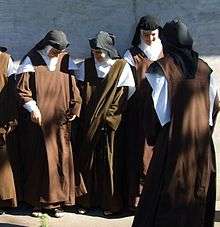
In the late 14th and 15th centuries the Carmelites, like a number of other religious orders, declined and reform became imperative. In 1432 the Carmelites obtained from Pope Eugenius IV the bull Romani pontificis, which mitigated the Rule of St Albert and the 1247 modification, on the ground that the original demanded too much of the friars. The main clauses modified concerned fasting and remaining within individual cells: the bull allowed them to eat meat three days a week and to perambulate in the cloisters of their convents. This reform brought the Carmelites closer into line with other mendicant orders, but it was also the source of much subsequent tension, as others refused to accept this change in the nature of the order, seeing it as a loss of Carmel's original vision and spirit.[23]
Such tension erupted almost immediately. Shortly before 1433 three priories in Valais, Tuscany, and Mantua were reformed by the preaching of Thomas Conecte of Rennes and formed the Congregation of Mantua,[6] refusing to accept the mitigation of 1432. They instead insisted on a more severe monastic observance than that applied between 1247 and 1432. Under the Mantuan observance, entrance to the cloister was forbidden to outsiders, the friars were banned from being outside the convent without good reason, and money was distributed from a common chest.[24] In 1443, they obtained a bull from Pope Eugenius IV which effectively declared the Mantua chapter independent of the rest of the order, with its own special set of constitutions and governed by its own vice prior general. Under the reconciliatory efforts of prior-general Blessed John Soreth (c. 1395–1471; prior-general 1451–1471), however, the Mantuan congregation was brought closer to the main Carmelite order, such that in 1462 the Mantuans even accepted parts of the 1432 mitigation.
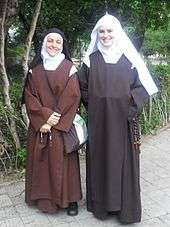
This was likely in part due to Soreth's own reforming impulses. In 1459, for instance, Pope Pius II left the regulation of fasts to the discretion of the prior general; Soreth accordingly sought until his death in 1471 to restore the primitive asceticism.
Soreth also founded the order of Carmelite nuns in 1452 (with authorisation from the papal bull Cum Nulla). The first convent, Our Lady of Angels, was in Florence, but the movement rapidly spread to Belgium (in 1452), France, and Spain (with the foundation of the Incarnation in Avila in 1479).
In 1476, a papal bull Cum nulla of Pope Sixtus IV founded the Carmelites of the Third Order. They received a special rule in 1635, which was amended in 1678.
The need for reform of the Carmelite order was recognized by the early sixteenth century, and some early attempts at reform were made then, notably from 1523 onwards by Nicholas Audet, vicar-general of the order. His plans saw some fruit: during three years of travels through France and Germany, introducing his reforms into the houses of the order, more than one hundred houses were reformed. Audet met resistance in other places, however: in the Spanish province of Castile, more than half the friars walked away.[25]
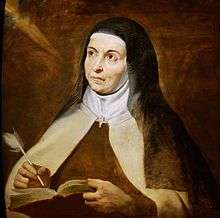
Reform in Spain began in earnest in the 1560s, with the work of Teresa of Ávila, who, together with John of the Cross, established the Discalced Carmelites. Teresa's foundations were welcomed by King Philip II of Spain, who was most anxious for all Orders to be reformed according to the principles of the Council of Trent (1545–1563). But she created practical problems at the grassroots level. The proliferation of new religious houses in towns that were already struggling to cope economically was an unwelcome prospect. Local townspeople resisted direction by the nobility and diocesan clergy. Teresa tried to make her monasteries as self-sufficient as was practicable, and restricted the number of nuns per community accordingly.
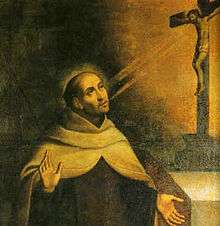
The Discalced Carmelites also faced much opposition from other unreformed Carmelite houses (notably, Carmelites from Toledo arrested and imprisoned John of the Cross in their own monastery). Only in the 1580s did the Discalced Carmelites gain official approval of their status. In 1593, the Discalced Carmelites had their own superior general styled propositus general, the first being Nicholas Doria. Due to the politics of foundation, the Discalced friars in Italy were canonically erected as a separate juridical entity.
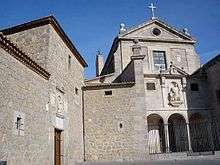
After the rise of Protestantism and the devastation of the French Wars of Religion, a spirit of reform renewed 16th–17th century France, as well as the Carmelite Order in France. In the late 16th century, Pierre Behourt began an effort to restore the state of the Province of Touraine, which was continued by the practical reforms of Philip Thibault. The Provincial Chapter of 1604 appointed Thibault the prior of the Convent in Rennes, and moved the Novitiate to Rennes, thereby ensuring that new members of the Province would be formed by the reform-minded friars.[26] The Observance of Rennes advocated poverty, the interior life and regular observance as the antidote to the laxity and decadence into which religious life had fallen, in addition, incorporating currents of renewal from the Discalced Reform, the French School, and the Society of Jesus. Thibault is said to have wished to marry the spirit of the society with the Order of Carmelites as far as possible.[27] One of the most renowned figures of the Reform was John of St. Samson, a blind lay brother, highly regarded for his humility and exalted spiritual life. In 1612, Br. John was moved to the Convent at Rennes and, in addition to playing the organ, served as the instructor and spiritual director of the novices. Thus John of St. Samson became known as the "Soul of the Reform." Eventually, the Observance of Rennes spread to priories throughout France, Belgium, and Germany, and became known as the Touraine Reform, after the Province from which the movement originated.[28]
Carmelite nunneries were established in New Spain (Mexico), the first founded in 1604 in Puebla de los Angeles, New Spain's second largest city, followed by one in the capital Mexico City 1616. In all, before Mexican independence in 1821, there were five Carmelite convents among 56 nunneries.[29]
Papebroch Controversy
Daniel Papebroch was a member of the Bollandist, a group of Jesuit hagiographers who produced the Acta Sanctorum, which took an analytical approach to the "Lives of the Saints". In his preliminary commentary on Albert of Vercelli, who is credited with the Carmelite Rule, Papebroch said that the tradition universally received by the Carmelites, that the origin of the order dated back to the prophet Elias, as its founder, was insufficiently grounded. The Carmelites took exception to this.[30]
From 1681 to 1693 there appeared between twenty or thirty pamphlets castigating Papebroch and his work. The series culminated in the large quarto volume signed by Father Sebastian of St. Paul, provincial of the Flemish-Belgian province of the Carmelite Order, which made serious charges against Papebroch's orthodoxy. Learning that steps were being taken to obtain a condemnation from Rome of the Acta Sanctorum, the Bollandists responded. Conrad Janninck replied first with open letters to Sebastian of St. Paul. The two letters were printed in 1693, followed by a more extended defense of the "Acta", published by Janninck in 1695. Papebroch published his rebuttal in 1696, 1697, and 1698 in the three volumes of the "Responsio Danielis Papebrochii ad Exhibitionem Errorum".[30]
When Rome did not issue a condemnation, the adversaries of Papebroch, had recourse to the tribunal of the Spanish Inquisition, which in November, 1695, issued a decree condemning the fourteen volumes of the Acta Sanctorum published up to that time, and branding it heretical. Janninck was sent Rome not only to prevent the confirmation by Rome of the decree of the Spanish Inquisition, but also to secure the retraction of the decree. In December, 1697, he received the assurance that no censure would be passed against the volumes condemned in Spain. On November 20, 1698, Pope Innocent XII issued a brief that ended the controversy by imposing silence on both parties. Whether it was judged prudent in Rome not to enter into conflict with the Spanish tribunal, or whether the latter prolonged the affair by passive resistance, the decree of condemnation made in 1695 was not revoked until 1715, the year following the death of Papebroch.[30]
Modern history
Since the 1430s, the Congregation of Mantua had continued to function in its little corner of Italy. It was only at the end of the 19th century that those following the reform of Tourraine (by this time known as the "strict observance") and the Mantuan Congregation were formally merged under one set of constitutions. The friars following Mantua conceded to Tourraine's Constitutions but insisted that the older form of the habit - namely their own - should be adopted. In a photograph of the period Blessed Titus Brandsma is shown in the habit of Tourraine as a novice; in all subsequent images he wears that of the newly styled Ancient Observance.
The French Revolution led to the suppression of the order, with the nuns dispersed into small groups who lived out of view in private houses. After the end of the disturbances the wealthy heiress and Carmelite nun Camille de Soyécourt did much to restore the order.[31] The secularization in Germany and the repercussions on religious orders following the unification of Italy were strong blows to the Carmelites.
By the last decades of the 19th century, there were approximately 200 Carmelite men throughout the world. At the beginning of the 20th century, however, new leadership and less political interference allowed a rebirth of the order. Existing provinces began re-founding provinces that had become defunct. The theological preparation of the Carmelites was strengthened, particularly with the foundation of St. Albert's College in Rome.
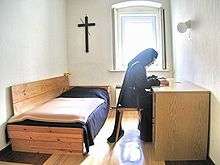
By 2001, the membership had increased to approximately 2,100 men in 25 provinces, 700 enclosed nuns in 70 monasteries, and 13 affiliated Congregations and Institutes. In addition, the Third Order of lay Carmelites count 25,000-30,000 members throughout the world. Provinces exist in Australia, Brazil, Britain, Canada, Chile, Hungary, Germany, India, Indonesia, Ireland, Italy, Malta, the Netherlands, Poland, Singapore, Spain, Portugal and the United States. Delegations directly under the Prior General exist in Argentina, France, the Czech Republic, the Dominican Republic, Lebanon, the Philippines and Portugal.
Carmelite Missions exist in Bolivia, Burkino Faso, Cameroon, Colombia, India, Kenya, Lithuania, Mexico, Mozambique, Peru, Romania, Tanzania, Trinidad, Venezuela and Zimbabwe.
Monasteries of enclosed Carmelite nuns exist in Brazil, Denmark, the Dominican Republic, Finland, Germany, Hungary, Indonesia, Iceland, Ireland, Israel, Italy, Kenya, the Netherlands, Australia, New Zealand (in Christchurch since 1933), Nicaragua, Norway, Peru, the Philippines, Spain, Sweden, Portugal, the United Kingdom and the United States. Hermit communities of either men or women exist in Brazil, France, Indonesia, Lebanon, Italy and the United States.
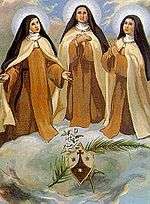
The Discalced Carmelite Order built the priory of Elijah (1911) at the site of Elijah's epic contest with the prophets of Ba'al (1 Kings 18:20-40). The monastery is situated about 25 kilometers south of Haifa on the eastern side of the Carmel, and stands on the foundations of a series of earlier monasteries. The site is held sacred by Christians, Jews and Muslims; the name of the area is el-Muhraqa, an Arabic construction meaning "place of burning", and is a direct reference to the biblical account.
Several Carmelite figures who have received significant attention in the 20th century, including Thérèse of Lisieux,[32] one of only four female Doctors of the Church,[33] so named because of her famous teaching on the "way of confidence and love" set forth in her best-selling memoir, "Story of a Soul";[34] Three nuns of Monastery of Guadalajara who were martyred on the 24th July 1936 by Spanish Republicans.[35] Titus Brandsma, a Dutch scholar and writer who was killed in Dachau concentration camp because of his stance against Nazism; and Teresa Benedicta of the Cross (née Edith Stein), a Jewish convert to Catholicism who was also imprisoned and died at Auschwitz.
Raphael Kalinowski (1835–1907) was the first friar to be canonized in the order since co-founder John of the Cross. The writings and teachings of Brother Lawrence of the Resurrection, a Carmelite friar of the 17th century, continue as a spiritual classic under the title The Practice of the Presence of God. Other non-religious (i.e., non-vowed monastic) great figures include George Preca, a Maltese priest and Carmelite Tertiary. The Feast of All Carmelite Saints and Blesseds is celebrated on November 14.[36]
Leaders of the Carmelite Order meet from time to time in General Congregation. The most recent General Congregation took place in Fátima, Portugal from 18 to 30 September 2016.[37]
Habit and scapular
| Part of a series on |
| Scapulars of the Catholic Church |
|---|
Sacramental garments |
| General |
| Specific scapulars |
|
|
|
In 1287, the original way of life of the order was changed to conform to that of the mendicant orders on the initiative of St. Simon Stock and at the command of Pope Innocent IV. Their former habit of a mantle with black and white or brown and white stripes—the black or brown stripes representing the scorches the mantle of Elijah received from the fiery chariot as it fell from his shoulders—was discarded. They wore the same habit as the Dominicans, except that the cloak was white. They also borrowed much from the Dominican and Franciscan constitutions. Their distinctive garment was a scapular of two strips of dark cloth, worn on the breast and back, and fastened at the shoulders. Tradition holds that this was given to St. Simon Stock by the Blessed Virgin Mary, who appeared to him and promised that all who wore it with faith and piety and who died clothed in it would be saved.[38][39][40] There arose a sodality of the scapular, which affiliated a large number of laymen with the Carmelites.
A miniature version of the Carmelite scapular is popular among Roman Catholics and is one of the most popular devotions in the Church. Wearers usually believe that if they faithfully wear the Carmelite scapular (also called "the brown scapular" or simply "the scapular") and die in a state of grace, they will be saved from eternal damnation. Catholics who decide to wear the scapular are usually enrolled by a priest, and some choose to enter the Scapular Confraternity. The Lay Carmelites of the Third Order of Our Lady of Mount Carmel wear a scapular which is smaller than the shortened scapular worn by some Carmelite religious for sleeping, but still larger than the devotional scapulars.
Visions and devotions
Among the various Catholic orders, Carmelite nuns have had a proportionally high ratio of visions of Jesus and Mary and have been responsible for key Catholic devotions.
From the time of her clothing in the Carmelite religious habit (1583) until her death (1607), Mary Magdalene de' Pazzi is said to have had a series of raptures and ecstasies.
- First, these raptures sometimes seized upon her whole being with such force as to compel her to rapid motion (e.g. towards some sacred object).
- Secondly, she was frequently able, whilst in ecstasy, to carry on working e.g., embroidery, painting, with perfect composure and efficiency.
- Thirdly, during these raptures Mary Magdalene de' Pazzi gave utterance to maxims of Divine Love, and to counsels of perfection for souls. These were preserved by her companions, who (unknown to her) wrote them down.
In the Carmelite convent of Beja, in Portugal, two Carmelite nuns of the Ancient Observance reported several apparitions and mystical revelations throughout their life: Venerable Mother Mariana of the Purification received numerous apparitions of the Child Jesus and her body was found incorrupt after her death;[41] Venerable Mother Maria Perpétua da Luz wrote 60 books with messages from heaven;[42] both religious died with the odor of sanctity.
In the 19th century, another Carmelite nun, Thérèse of Lisieux, was instrumental in spreading devotion to the Holy Face[43] throughout France in the 1890s with her many poems and prayers. Eventually Pope Pius XII approved the devotion in 1958 and declared the Feast of the Holy Face of Jesus as Shrove Tuesday (the day before Ash Wednesday) for all Catholics. Therese of Lisieux emerged as one of the most popular saints for Catholics in the 20th century, and a statue of her can be found in many European and North American Catholic churches built prior to the Second Vatican Council (after which the number of statues tended to be reduced when churches were built).
In the 20th century, in the last apparition of the Blessed Virgin Mary in Fátima, Portugal, Sister Lúcia, one of the most famous visionaries of Our Lady, said that the Virgin appeared to her as Our Lady of Mount Carmel (holding the Brown Scapular). Many years after, Lúcia became a Carmelite nun. When Lúcia was asked in an interview why the Blessed Virgin appeared as Our Lady of Mount Carmel in her last apparition, she replied: "Because Our Lady wants all to wear the Scapular... The reason for this", she explained, "is that the Scapular is our sign of consecration to the Immaculate Heart of Mary". When asked if the Brown Scapular is as necessary to the fulfillment of Our Lady's requests as the rosary, Lúcia answered: "The Scapular and the Rosary are inseparable".[44]
Many Carmelites have been canonized by the Catholic Church as saints. November 14 is the Feast of All Carmelite Saints.[45]
See also
- Enclosed religious orders
- Dialogues of the Carmelites
- Ipswich Whitefriars
- Anglican religious order § Carmelite orders
Other Branches of the Carmelite Order
- Byzantine Discalced Carmelites
- Carmelites of Mary Immaculate
- Discalced Carmelites (also known as Teresian Carmelites)
- Hermits of the Most Blessed Virgin Mary of Mount Carmel
- Lay Carmelites (Third Order of Our Lady of Mount Carmel)
- Monks of the Most Blessed Virgin Mary of Mount Carmel
- Secular Order of Discalced Carmelites
- Episcopal Carmel of Saint Teresa
Communities of Carmelite Sisters
Spirituality
- Thérèse of Lisieux (Doctor of the Church)
- Mary Magdalene de' Pazzi
- Sister Lúcia of Fátima
- Nuno of Saint Mary
- Simon Stock
- Elizabeth of the Trinity
- Marie-Antoinette de Geuser "Consumata"
- Edith Stein "Teresa Benedicta of the Cross"
- Teresa of Los Andes
- Teresa Margaret of the Sacred Heart
- Joaquina de Vedruna
- Angelus of Jerusalem
- Brother Lawrence of the Resurrection
- Francisco Palau
- Angelo Paoli
- Jan Tyranowski
- Martyrs of Compiègne
- Titus Brandsma
- John of St. Samson
Tradition
Notes
- "CATHOLIC ENCYCLOPEDIA: The Carmelite Order". www.newadvent.org. Retrieved May 24, 2019.
- Not until the late fourteenth century was 'B,' the prior of the earliest known community of Carmelites, expanded to read Brocard. See Keith J Egan, "The Spirituality of the Carmelites," in Jill Raitt with Bernard McGinn and John Meyendorff, eds, Christian Spirituality: High Middle Ages and Reformation, (London: SCM, 1989), p. 50. See also Herbermann, Charles, ed. (1913). . Catholic Encyclopedia. New York: Robert Appleton Company.
- Carmelite Nuns of Great Britain, Our History, accessed 19 December 2019
- "The Carmelite Charism: Contemplation". Archived from the original on 2013-06-03.
- Benedetto, Robert; Duke, James O., eds. (2008). "Carmelite Order". The New Westminster Dictionary of Church History: The early, medieval, and Reformation eras. Westminster John Knox Press. p. 123. ISBN 0664224164.CS1 maint: ref=harv (link)
- "A Brief History of The Carmelites - THE OFFICIAL WEBSITE OF THE CARMELITE ORDER".
- Andrew Jotischky,The Carmelites and Antiquity: Mendicants and Their Pasts in the Middle Ages, (Oxford, 2002), p.12
- Probably as a result of an invitation from Sir Richard Grey of Codnor, who had gone on Crusade, landing at Acre in October 1240. He probably met the order here, and offered them sanctuary on his lands.
- Much legend surrounds Simon Stock, generally emerging in late fourteenth century hagiography. Keith J Egan, "The Spirituality of the Carmelites," in Jill Raitt with Bernard McGinn and John Meyendorff, eds, Christian Spirituality: High Middle Ages and Reformation, (London: SCM, 1989), p50
- Alison Cameron; Judith A. Stones; Chris Croly (2019). "Excavations at Aberdeen's Carmelite Friary, 1980-1994". Internet Archaeology. 52. doi:10.11141/ia.52.1. Retrieved 14 May 2019.
- Andrew Jotischky,The Carmelites and Antiquity: Mendicants and their pasts in the Middle Ages, (Oxford, 2002), p14
- Peter Tyler, 'Carmelite Spirituality', in Peter Tyler, ed, The Bloomsbury Guide to Christian Spirituality, (2012), p118
- Jotischky, The Carmelites and Antiquity, (2002), p16
- Peter Tyler, 'Carmelite Spirituality', in Peter Tyler, ed, The Bloomsbury Guide to Christian Spirituality, (2012), p120
- The Carmelite claim to stand in a direct line of descent from Elijah as contemplatives on Mount Carmel is featured in the first lines of the Constitutions of 1281, the so-called Rubrica Prima, a document probably originating in the 1240s. This was most influentially put forward, though, in a series of works by Philip Ribot (d1391), including The Institution of the First Monks, which powerfully established a Carmelite foundational myth. See John Welch, The Carmelite Way, (1996), p52
- John Welch, The Carmelite Way (1996), p10
- Andrew Jotischky, The Carmelites and Antiquity (2002), p24
- Translated by Bede Edwards in The Sword, (June 1979), pp3-52
- Richard Copsey argues that the Ignea Sagitta was unknown until the early fifteenth century, raising the question whether it was ever publicly issued.
- In 1271, Nicholas disappears from the historical record. It is unclear whether he resigned, or, as Richard Copey believes, died.
- Keith J Egan, 'The Spirituality of the Carmelite Order', in Jill Raitt with Bernard McGinn and John Meyendorff, eds, Christian Spirituality: High Middle Ages and Reformation, (London: SCM, 1989), p56.
- By Otger Steggink
- Jotischky, The Carmelites and Antiquity (2002), p41
- John Welch, The Carmelite Way, (1996), p13
- John Welch, The Carmelite Way, (1996), p17
- Smet, Joachim. The Mirror of Carmel: A Brief History of the Carmelite Order. 2011: Carmelite Media. pp. 230–232.CS1 maint: location (link)
- Bremond, Henri (1930). A Literary History of Religious Thought in France from the Wars of religion Down to Our Own Times; Vol. 2 [II], The Coming of Mysticism (1590-162). Society for Promoting Christian Knowledge. p. 275.
- Smet, Joachim. The Mirror of Carmel: A Brief History of the Carmelite Order. pp. 233–235.
- Asunción Lavrin, Brides of Christ: Conventual Life in Colonial Mexico. Stanford: Stanford University Press 2008, pp.359-71.
- De Smedt, Charles. "The Bollandists." The Catholic Encyclopedia Vol. 2. New York: Robert Appleton Company, 1907. 2 May 2020

- Mère Saint-Jérôme (1851), La Vie de la Révérende Mère Thérèse Camille de Soyécourt, carmélite (in French), Vve Poussielgue-Rusand, p. 309, retrieved 16 February 2017
- ""Saint Therese of Lisieux: A Gateway" Blog - Saint Therese of Lisieux".
- O’Riordan, Maureen. "Doctor of the Universal Church". Saint Therese of Lisieux: A Gateway. Retrieved April 4, 2010.
- O’Riordan, Maureen. "Writings". Saint Therese of Lisieux: A Gateway. Retrieved April 4, 2010.
- "The Carmelite Martyrs of Guadalajara". Jun 2, 2013. Retrieved May 24, 2019.
- "All Carmelite Saints (Feast) - THE OFFICIAL WEBSITE OF THE CARMELITE ORDER".
- Order of Carmelites, General Congregation Final Statement, accessed 26 October 2018
- EWTN "History of the Scapular"
- Matthew Bunson, 2008, The Catholic Almanac, ISBN 978-1-59276-441-9 page 155
- Gerald M. Costello, 2001, Treasury of Catholic Stories, OSV Press, ISBN 978-0-87973-979-9, page 128
- SERPA, J. J. Gonçalves; Venerável Madre Mariana da Purificação: Carmelita Calçada de Beja. Colecção: Almas heróicas de Beja; 230pp.; Gouveia: 1960.
- SANTA ANNA, Frei Joseph Pereira de; Vida da Insigne Mestra de Espírito, a Virtuosa Madre Maria Perpétua da Luz, Religiosa Carmelita Calçada; Lisboa: Oficina de Antonio Pedrozo, 1742.
- O’Riordan, Maureen. "Therese and the Holy Face of Jesus". Saint Therese of Lisieux: A Gateway. Retrieved April 4, 2010.
- Haffert, James Mathias; Mary in Her Scapular Promise. AMI Press, 1954.
- "The Carmelite Ordo | THE WEBSITE OF THE CARMELITE ORDER | WELCOME". ocarm.org. Retrieved May 24, 2019.
References
- Schaff-Herzog Encyclopedia of Religion
- Copsey, Richard and Fitzgerald-Lombard, Patrick (eds.), Carmel in Britain: studies on the early history of the Carmelite Order (1992–2004).
- "The Carmelite Order" by Benedict Zimmerman. The Catholic Encyclopedia, 1908.
Further reading
- T. Brandsma, Carmelite Mysticism, Historical Sketches: 50th Anniversary Edition, (Darien, IL, 1986), ASIN B002HFBEZG
- J. Boyce, Carmelite Liturgy and Spiritual Identity. The Choir Books of Kraków, Turnhout, 2009, Brepols Publishers, ISBN 978-2-503-51714-8
- W. McGreal, At the Fountain of Elijah: The Carmelite Tradition, (Maryknoll, NY, 1999), ISBN 1-57075-292-3
- J. Smet, The Carmelites: A History of the Brothers of Our Lady of Mt. Carmel, 4. vol. (Darien IL, 1975)
- J. Welch, The Carmelite Way: An Ancient Path for Today’s Pilgrim, (New York: 1996), ISBN 0-8091-3652-X
External links
| Wikimedia Commons has media related to Carmelites. |
- Order of the Brothers of Our Lady of Mount Carmel
- Order of the Discalced Carmelites
- Index of Carmelite Websites
- Carmelite Hermitage
- Meditations from Carmel
- "Sayings of Light and Love" - Spiritual Maxims of John of the Cross
- The Carmelite history and vocation
- "Mystical Brain" by Isabelle Raynauld (2006) - a documentary film about five Carmelite Nuns who volunteered to have their brains scanned while they meditated by recalling mystical experiences
Provinces of the Carmelite Order
- Carmelites of the Province of the Assumption, British Province (founded c. 1241; refounded 1969)
- Carmelites of the Most Pure Heart of Mary Province, USA/Canada/Peru/Mexico/El Salvador (founded 1890)
- Carmelites of the North American Province of St. Elias (founded 1931)
